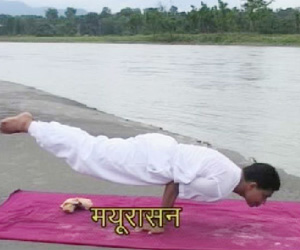Mayurasana | Peacock Pose
Mayur in Sanskrit language means ‘peacock’, in this posture, the body takes the shape of peacock. In this asana, one has to hold the whole body like a stick on the both elbows.
Process
1. Start with sitting on knees and place the palms on ground while finger pointing towards stomach.
2. Take a deep breath and place both elbows on both sides of navel now raise the thighs, buttock. Head and knees will be parallel to each other.
3. Keep the knees one feet from each other.
4. Keep the wrists and palms towards the knees
5. Place the entire weight on the palms, hands, and elbows and maintained the balance.
6. Exhale to return to original state and relax.
Duration
Hold the breath for two to four seconds and repeat it from two to three times, extended up to one minute later on.
Benefits
- Improves digestive system.
- Cleans bowels.
- It increases gastric juices and can whet the appetite.
- Helps to cure diseases of intestines and stomach.
- Cures diabetes.
- Strengthens the wrists,arms,lungs,ribs.
- Tones up liver.
- Improves pancreas.
Precaution
- Person with the problem of cervical spondylitis should avoid this asana to avoid any problem later on.
- Patient of high blood pressure should avoid this posture.
- Avoid this asana in case you have abdominal surgery done.
- Don’t jerk while doing this asana at any stage.
- Stop doing this posture if you feel imbalance while performing.
- Patient of hernia or ulcer should avoid it.
